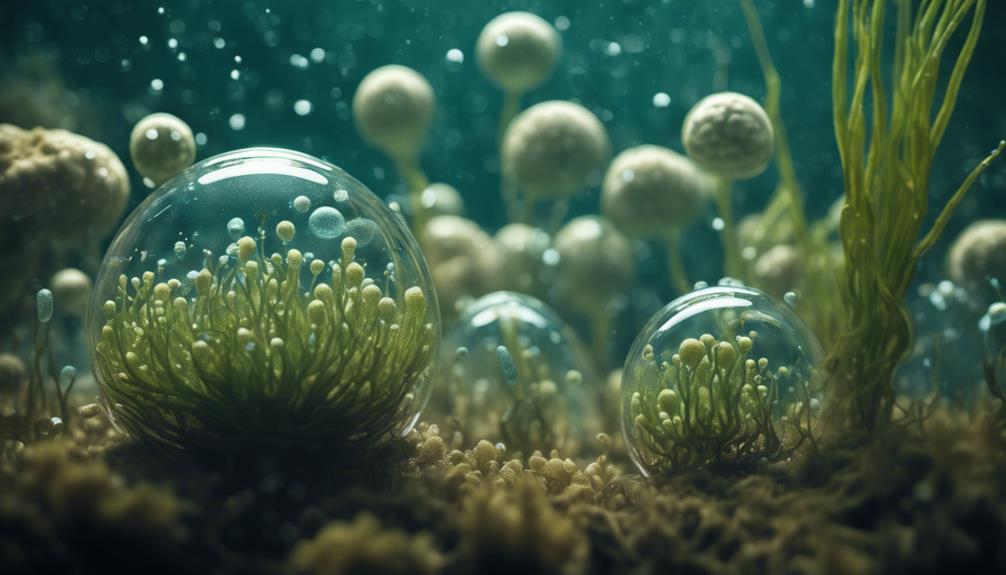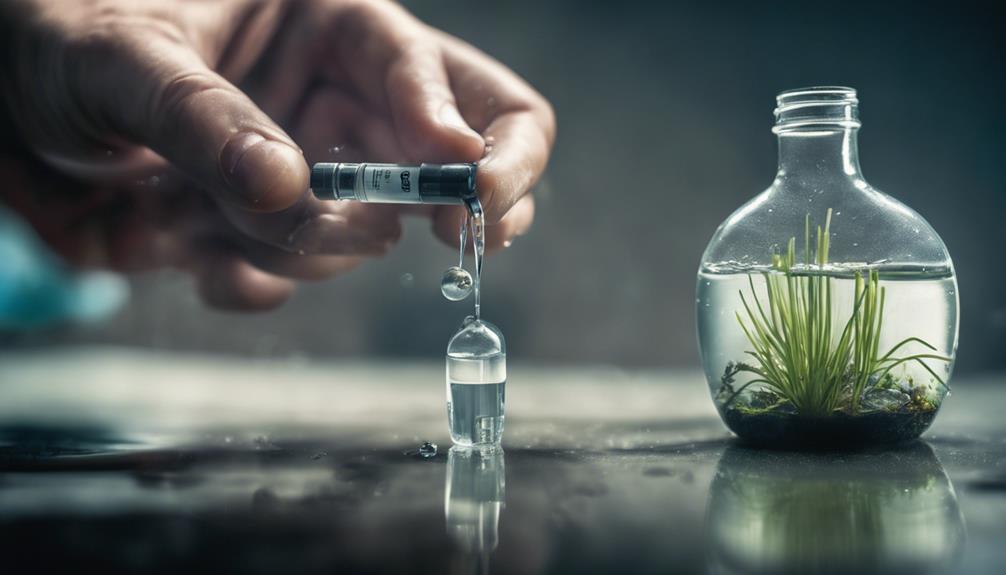You can harness the power of certain aquatic plants to boost water quality rapidly. These plants remove up to 90% of heavy metals and toxins from water, creating a healthier environment for aquatic organisms. Oxygen plays a vital role in plant respiration, ensuring peak root function and water quality. By optimizing oxygen levels, you can enhance plant growth and water purification. Nanobubble technology, which injects oxygen-rich nanobubbles into water, is a chemical-free method that furthers water quality improvement. Exploring the benefits of nanobubble technology and real-world applications can reveal the full potential of plants in water purification, leading you to discover more about the intricacies of water quality enhancement.
Table of Contents
Key Takeaways
- Aquatic plants remove up to 90% of heavy metals and toxins from water, improving water quality more efficiently than other methods.
- Plants like water hyacinth absorb pollutants and excess nutrients, creating a healthier environment for aquatic organisms to thrive.
- Plants' ability to reduce excess nutrients in water prevents eutrophication, maintaining a balanced ecosystem and promoting faster water quality improvement.
- Optimizing oxygen levels in irrigation water directly impacts plant growth rate and crop yield, supporting aquatic life and water quality improvement.
- Certain plants' natural purification capabilities, like removing bacteria and viruses, make them valuable tools in natural water purification systems, boosting water quality faster.
Plants as Natural Water Purifiers
Frequently, you'll find that aquatic plants are employed as natural water purifiers, harnessing their remarkable ability to absorb and remove pollutants from water.
These plants, such as water hyacinth, are capable of removing up to 90% of heavy metals and toxins from the water, substantially improving water quality.
Through their nutrient uptake, they reduce the amount of excess nutrients in the water, preventing eutrophication and maintaining a balanced ecosystem.
This process not only improves water quality but also supports aquatic life.
By absorbing pollutants and excess nutrients, aquatic plants create a healthier environment for aquatic organisms to thrive.
For instance, water hyacinth is known to remove bacteria and viruses from water, making it a valuable tool in natural water purification systems.
Oxygen's Role in Water Quality
As you explore the role of oxygen in water quality, you'll find that it plays a critical part in plant respiration, serving as the final electron acceptor to guarantee peak root function.
When oxygen levels in irrigation water are limited, it can hinder ATP production, water and nutrient absorption, and overall plant growth rate and crop yield.
Oxygen's Impact
When you optimize oxygen levels in the irrigation water, you directly impact plant respiration, ensuring ideal root function and overall plant growth rate and crop yield.
Limited oxygen in the water limits ATP production, water, and nutrient absorption, ultimately affecting plant growth and yield.
In contrast, high oxygen levels promote beneficial biology in the substrate, reducing the need for additional additives.
Oxygen nanobubbles can even increase oxygen levels to over 200% saturation, essential for peak plant performance and maximum yields.
Good oxygen levels in the substrate lead to healthy roots and healthy plants.
Oxygen-rich water is essential for peak plant performance and maximum yields.
By optimizing oxygen levels, you create an environment where plants can thrive.
This is particularly vital in greenhouses, especially in warmer climates, where oxygenation of the root zone has a high payoff.
By prioritizing oxygen levels, you're ensuring your plants have the best chance to grow and flourish.
Optimal Root Function
Optimizing oxygen levels in irrigation water directly supports ideal root function by facilitating efficient nutrient uptake and water absorption, which in turn promotes healthy plant growth and development. As you work to boost water quality, you'll want to focus on optimizing root function to guarantee your plants can absorb nutrients effectively.
| Root Function | Nutrient Uptake | Water Absorption |
|---|---|---|
| Ideal | Efficient | Rapid |
| Compromised | Inhibited | Slowed |
| Peak | Enhanced | Maximized |
When oxygen levels are peak, your plants' roots can function at their best, allowing them to absorb nutrients from the water and soil more efficiently. This, in turn, supports healthy plant growth and development. Conversely, low oxygen levels can compromise root function, leading to inhibited nutrient uptake and slowed water absorption. By prioritizing peak root function, you can create an environment that supports the health and vitality of your plants, which in turn can help boost water quality.
Nanobubble Technology Explained

You're about to explore the innovative world of nanobubble technology, which is transforming the way we treat irrigation water.
To understand its benefits, you need to know how nanobubbles are formed and how they're used to treat water.
Let's break down the nanobubble formation process and its application in water treatment, and see how it can revolutionize your irrigation system.
Nanobubble Formation Process
Using a specialized device, such as a Moleaer nanobubble generator, you can create nanobubbles through a process called cavitation.
This process involves the formation and subsequent collapse of micro-bubbles in water, which injects air or oxygen into the water under high pressure, creating the necessary conditions for cavitation to occur.
The resulting nanobubbles measure 70-200 nanometers in diameter, making them incredibly effective at increasing oxygen levels, reducing pathogens, and improving water quality.
Nanobubble Water Treatment
By incorporating nanobubble technology into their water treatment process, growers and farmers can harness the power of oxygen-rich nanobubbles to create a healthy and pathogen-free environment for their crops to thrive.
This chemical-free method prevents and destroys root disease and biofilm accumulation, promoting healthy plant growth and high yields.
As you implement nanobubble technology, you'll notice oxygen levels in the substrate increasing to over 200% saturation, leading to healthy roots and peak plant performance.
The tiny nanobubbles, measuring 70-200 nanometers in diameter, penetrate deeply into the root zone, interacting with plant roots and providing a healthy exchange of water and nutrient.
Furthermore, the reactive oxygen species (ROS) produced by nanobubbles disrupt pathogen cell physiology, leading to cell death and preventing the growth of pathogens and algae in irrigation water.
This means you can say goodbye to heavy metals and other contaminants, and hello to a balanced and thriving ecosystem.
With over 1500 successful installations in 32 countries, you can trust that nanobubble technology is a reliable solution to boost water quality and take your crops to the next level.
Benefits of Nanobubble Treatment
Nanobubble treatment substantially enhances water quality by introducing oxygen-rich nanobubbles that promote beneficial biology, reduce pathogen growth, and stimulate plant growth hormones. As you explore the benefits of nanobubble technology, you'll discover how it can revolutionize your irrigation system. By increasing oxygen levels in the substrate to over 200% saturation, nanobubbles create an ideal environment for healthy plant growth.
| Benefit | Description |
|---|---|
| Pathogen Reduction | Nanobubbles produce reactive oxygen species (ROS) that disrupt pathogen cell physiology, leading to cell death. |
| Nutrient Absorption | Nanobubble treatment stimulates synthesis of growth hormones and up-regulates plant nutrient absorption genes, resulting in increased nutrient uptake. |
| Crop Yield | Oxygen-saturated water speeds up growth and increases crop turns per year, reducing crop turns from four weeks to three weeks with no signs of root disease. |
| Water Quality | High-quality irrigation water is well oxygenated and properly disinfected, reducing the risk of disease encroachment and promoting healthy plant growth. |
Real-World Applications of Nanobubbles

You can witness the impact of nanobubble technology in various industries and locations worldwide, where it has been successfully implemented to improve water quality and promote healthy plant growth.
With over 1500 installations in 32 countries, this technology has proven its effectiveness in agriculture, aquaculture, and wastewater treatment.
In greenhouses, for instance, nanobubble technology has been used to increase oxygen levels in the substrate, leading to healthy roots and plants.
Bux-Mont Hydroponics in Telford, PA, is a great example of how this technology can improve water quality and crop yield. By integrating nanobubble technology into their irrigation systems, they achieved higher oxygenation levels and outstanding disinfection.
As a result, you can enjoy the benefits of nanobubble technology in your own gardening or farming practices, knowing that it's a cost-effective and environmentally friendly solution for improving water quality.
With over 400 million gallons of water naturally disinfected daily, you can trust that this technology is making a significant impact in promoting healthy plant growth and sustainable water management.
Case Studies: Improved Water Quality
Real-world examples of improved water quality through nanobubble technology are plentiful, with numerous case studies demonstrating its effectiveness in various industries.
Bux-Mont Hydroponics in Telford, PA, reported improved water quality through higher oxygenation levels and outstanding disinfection after installing a Moleaer nanobubble generator.
Globally, over 1500 installations of nanobubble technology in 32 countries have resulted in improved water quality and reduced disease encroachment, with more than 500 greenhouse businesses benefiting from this technology.
In addition, a study found that nanobubble-treated water increased morphological characteristics, chlorophyll, phenol, flavonoid content, enzymatic and non-enzymatic antioxidants, and mineral content in plants.
Oxygen-saturated water has been shown to speed up growth and increase crop turns per year, with one case study reporting a reduction in crop turns from four weeks to three weeks with no signs of root disease.
It's clear that nanobubble technology is a game-changer for industries where water must be of high quality.
Importance of Water Testing and Filtration

When it comes to maintaining ideal water quality for your greenhouse crops, regular testing and filtration are essential components of your water management strategy. You need to verify the water you're using is suitable for irrigation, and laboratory testing is necessary to analyze its quality.
You should test your water every 1-3 months or when changes in water quality are suspected. During testing, you'll want to conduct pH and alkalinity tests together, as high pH doesn't always indicate high alkalinity.
To prevent clogging of your irrigation systems, filtration is vital. Use a screen or disk filter for most applications. A 200 mesh filter is recommended for micro-irrigation. Regularly clean your filters when the pressure variation between the two gauges exceeds 10%.
Optimizing Water Quality for Plant Growth
Optimizing water quality for plant growth requires careful attention to oxygen levels, as they play a critical role in supporting plant respiration and overall performance.
You see, plants require oxygen as the final electron acceptor in their respiration process, guaranteeing excellent root function and overall growth. Limited oxygen in irrigation water can lead to reduced ATP production, water and nutrient absorption, and overall plant growth rate and crop yield.
That's why oxygen-rich water is essential for peak plant performance and maximum yields. By promoting beneficial biology in the substrate, higher oxygen levels reduce the need for additional additives, leading to healthy roots and plants.
To achieve peak water quality, you can utilize oxygen nanobubble technology, which can increase oxygen levels in the substrate to over 200% saturation.
This not only creates conditions that reduce the growth of pathogens and algae but also increases dissolved oxygen (DO) and oxidation-reduction potential (ORP) of irrigation water.
Frequently Asked Questions
Why Do Plants Help Improve Water Quality?
You find that plants improve water quality by utilizing their root depth to absorb excess nutrients, adapting to various soil types, and creating habitats within aquatic ecosystems, ultimately enhancing the overall water purification process.
What Effect Do Plants Have on Water Quality?
Can you imagine a world without aquatic life? You're about to discover how plants impact water quality. Through their root system, plants absorb excess nutrients, reducing water pollution, and creating a thriving environment for aquatic life.
How Do Trees Help Improve Water Quality?
You'll find that trees along riverbanks help improve water quality by stabilizing soil, preventing erosion, and allowing for soil aeration, while their leaves absorb pollutants, effectively filtering out contaminants and purifying the water.
Is More Water Always Better When Growing Plants?
When you're growing plants, don't assume more water is always better, as it can lead to water scarcity and decreased soil absorption, ultimately hindering nutrient uptake – a delicate balance you must strike for ideal growth.
Conclusion
Certain plants are superheroes when it comes to boosting water quality.
By harnessing the power of nanobubble technology, these natural wonders can purify water at lightning speed. Imagine a trillion tiny scrubbers working tirelessly to cleanse your water – that's fundamentally what's happening!
With real-world applications and case studies backing up their effectiveness, it's clear that these plants are the MVPs of water quality improvement.
By optimizing water quality for plant growth, you'll release the full potential of these aquatic heroes.

